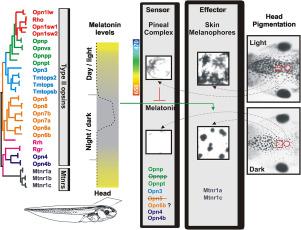Journal of Photochemistry and Photobiology B: Biology ( IF 3.9 ) Pub Date : 2020-09-11 , DOI: 10.1016/j.jphotobiol.2020.112024 Gabriel E Bertolesi 1 , Karen Atkinson-Leadbeater 2 , Emma M Mackey 3 , Yi N Song 3 , Belinda Heyne 4 , Sarah McFarlane 1

|
Coupling skin colour with the light/dark cycle helps regulate body temperature in ectotherms. In X. laevis, nocturnal release of melatonin from the pineal complex induces pigment aggregation and skin lightening. This nocturnal blanching is initiated by a sensor (type II opsin) that triggers melatonin release when light intensity falls below a minimum threshold, and an effector (melatonin receptor) in the skin which induces pigment aggregation. The sensor/s and effector/s belong to two families of G-protein coupled receptors that originated from a common ancestor, but diverged with subsequent evolution. The aim of this work was to identify candidate sensor/s and effector/s that regulate melatonin-mediated skin colour variation. In X. laevis, we identified a developmental time (stage 43/44) when skin lightening depends on pineal complex photosensitivity alone. At this stage, the pineal complex comprises the frontal organ and pineal gland. A total of 37 type II opsin (14 duplicated) and 6 melatonin receptor (3 duplicated) genes were identified through a full genome analysis of the allotetraploid, X. laevis. These genes were grouped into subfamilies based on their predicted amino acid sequences and the presence of specific amino acids essential for their function. The pineal complex expresses mainly blue light sensitive opsins [pinopsin, parietopsin, opn3, and melanopsins (opn4 and opn4b)] and UV-light sensitive opsins (opn5 and parapinopsin), while visual opsins and va-ancient opsin are absent, as determined by RT-PCR and in situ hybridization. The photoisomerase retinal G-protein coupled receptor, and an uncharacterized opn6b opsin, are also expressed. The spectral sensitivity that triggers melatonin secretion, and therefore melanophore aggregation, falls in the visible spectrum (470–650 ηm) and peaks in the blue/green range, pointing to the involvement of opsins with sensitivities therein. The effector-melatonin receptors expressed in skin melanophores are mtnr1a and mtnr1c. Our data point to candidate proteins required in the neuroendocrine circuit that underlies the circadian regulation of skin pigmentation, and suggest that multiple initiators and effectors likely participate.
中文翻译:

松果体II型视蛋白和皮肤褪黑素褪黑激素受体对环境色素的调节。
肤色与明/暗循环的耦合有助于调节体温(例如体温)。在X. laevis中,褪黑激素从松果体的夜间释放引起色素聚集和皮肤增白。夜间变白是由传感器(II型视蛋白)引发的,该传感器在光强度低于最小阈值时触发褪黑激素释放,并在皮肤中诱导色素沉着的效应子(褪黑激素受体)。传感器和效应子属于G蛋白偶联受体的两个家族,其起源于共同祖先,但是随着随后的进化而发散。这项工作的目的是确定调节褪黑激素介导的皮肤颜色变化的候选传感器和效应器。在X. laevis,我们确定了亮肤仅取决于松果体光敏性的发育时间(第43/44期)。在这个阶段,松果体由额叶器官和松果体组成。通过对异源四倍体X.laevis进行全基因组分析,总共鉴定出37个II型视蛋白(14个重复)和6个褪黑素受体(3个重复)基因。这些基因根据其预测的氨基酸序列和其功能必不可少的特定氨基酸的存在,分为亚家族。松果体复合物主要表达对蓝光敏感的视蛋白(pinopsin,parietopsin,opn3和melanopsins(opn4和opn4b))和对紫外线敏感的视蛋白(opn5且p arapinopsin),而视觉视蛋白和VA-古视蛋白不存在,如通过RT-PCR和确定原位杂交。所述photoisomerase视网膜G蛋白偶联受体,和未表征opn6b视蛋白,也被表达。触发褪黑素分泌的光谱敏感性,从而导致褪黑素聚集,在可见光谱(470–650ηm)内下降,并在蓝/绿范围内达到峰值,表明视蛋白与其中的敏感性有关。皮肤黑素细胞中表达的效应褪黑激素受体是mtnr1a和mtnr1c。我们的数据指出了神经内分泌回路中所需的候选蛋白质,这些蛋白质是皮肤色素沉着的昼夜节律调节的基础,并表明可能存在多种引发剂和效应子。











































 京公网安备 11010802027423号
京公网安备 11010802027423号